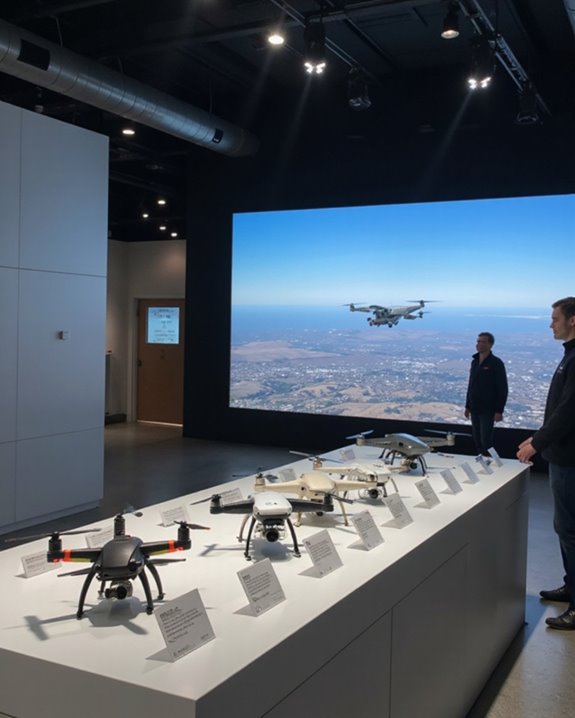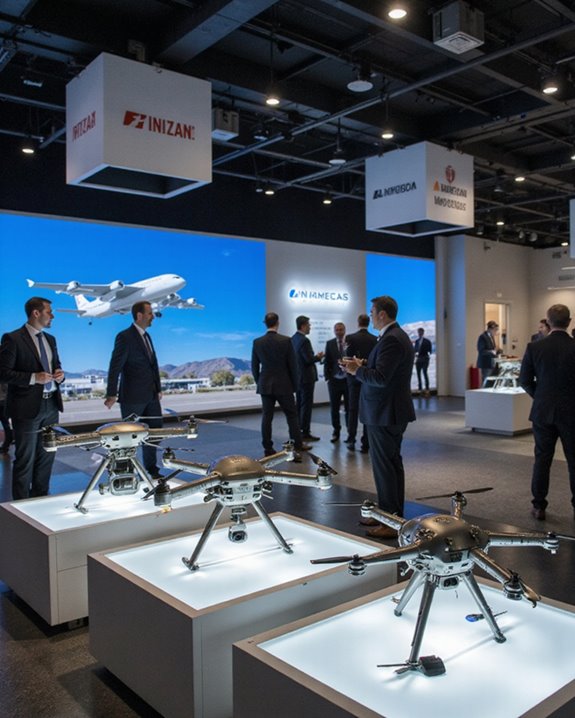Yes, drones are mostly imported from China, where brands like DJI (think Phantom and Mavic!) dominate nearly 70% of the global market. These high-tech marvels, packed with AI navigation and camera features, roll off Chinese assembly lines and take flight worldwide—from inspecting German wind turbines to delivering pizza in Tokyo. China’s manufacturing muscle, smart government policies, and relentless innovation keep it way out in front. Curious what drives these trade winds and shapes global trends?
Key Takeaways
- China is the world’s leading drone manufacturer, with companies like DJI holding about 70% of the global market share in 2024.
- Most commercial and consumer drones worldwide are primarily imported from China due to its advanced technology and manufacturing scale.
- Chinese drones dominate exports to regions like Asia-Pacific, Europe, and North America, shaping global supply and innovation trends.
- Trade policies, tariffs, and export controls can impact the flow of Chinese drones but do not significantly diminish their global presence.
- Other countries are investing in domestic drone industries, but China remains the primary source for imported drones globally.
Global Drone Market Size and Growth
The global drone market is soaring to new heights—literally and financially! Growth forecasts are impressive: in 2023, the market’s size projection hit $42.6 billion, and by 2024 it’s expected to reach nearly $48 billion. If you think that’s big, hold onto your propellers—some estimates predict the market could skyrocket to $123 billion by 2032! Drones aren’t just for fun; they’re working hard in agriculture, infrastructure inspection, delivery services, and even the military. Commercial drones alone are expected to double in value, hitting $37.3 billion by 2029. Market size estimates do vary, with some sources suggesting $208 billion by 2032, so there’s definitely a buzz about drones’ future. One thing’s certain: technological advancements are fueling this high-flying growth! Many profitable opportunities arise in sectors like agricultural drone services, which provide crop monitoring and precision farming solutions with recurring revenue from seasonal contracts.
China’s Role in Drone Manufacturing and Exports
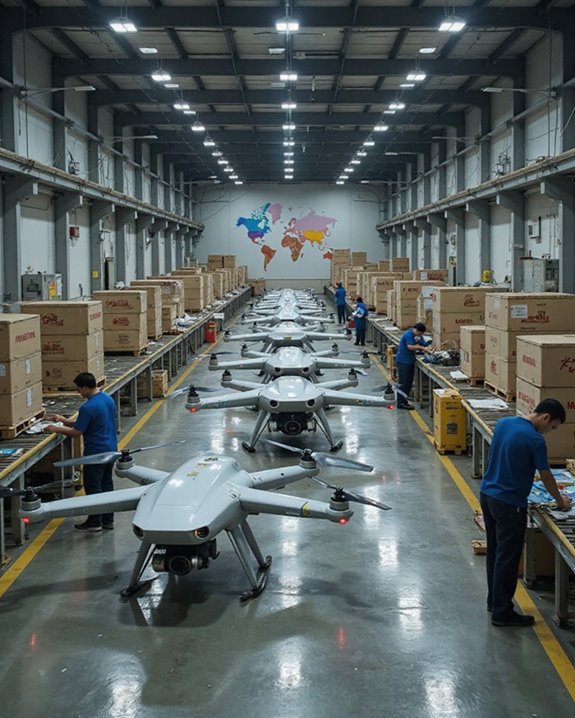
Step into the world of drone manufacturing, and you’ll quickly notice China’s massive presence—kind of like spotting the biggest drone at a tech fair! China’s factories, led by giants like DJI, buzz with activity, producing drones at lightning speed. Their secret sauce? Advanced technology, massive manufacturing capacity, and a workforce trained to handle the latest innovations. With initiatives like “Made in China 2025,” the country prioritizes both workforce training and sustainability practices, ensuring drones aren’t just high-tech but also eco-friendly. Chinese drones fly worldwide—especially to Asia-Pacific—thanks to smooth export processes and competitive pricing. The influence is huge: whenever China launches a new feature or improves their sustainability practices, global trends shift. It’s not just dominance; it’s setting the pace! Many of these drones, such as the popular DJI Mini series, are designed with features like under 249g weight to meet international regulations and enhance portability.
Economic and Trade Factors Influencing Drone Imports
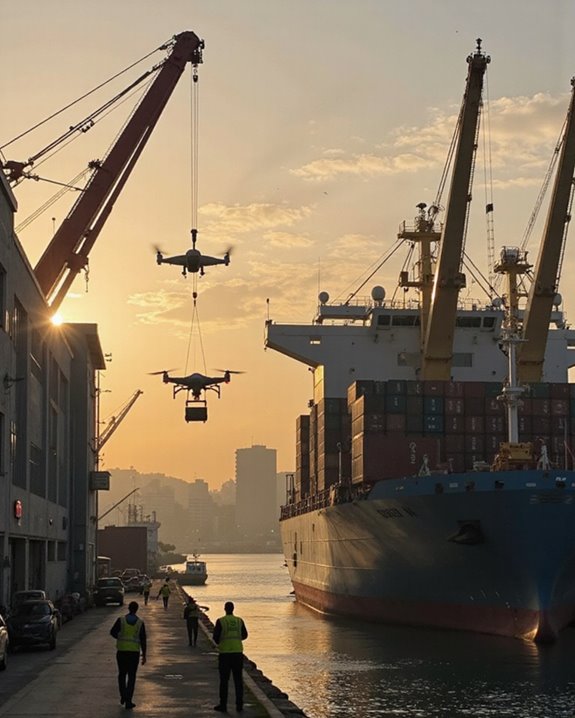
Plenty of things shape how drones make their way from China’s high-tech factories to skies all around the world, but it’s not just about picking the coolest gadget off the shelf! Economic and trade factors play a huge part—think Tariff Policies, which can make drones cost more or less depending on where you live. Sometimes, new tariffs or trade disputes between countries can shake up prices or even cause supply disruptions, making it tricky for companies to get the drones they need. Free trade agreements, regional blocs like the EU or ASEAN, and export controls also set the rules of the game. Finally, complex global supply chains—full of different parts and unexpected hiccups—mean that logistical challenges can delay drone arrivals, no matter how impatient buyers might be!
Technological Innovations Driving Import Demand
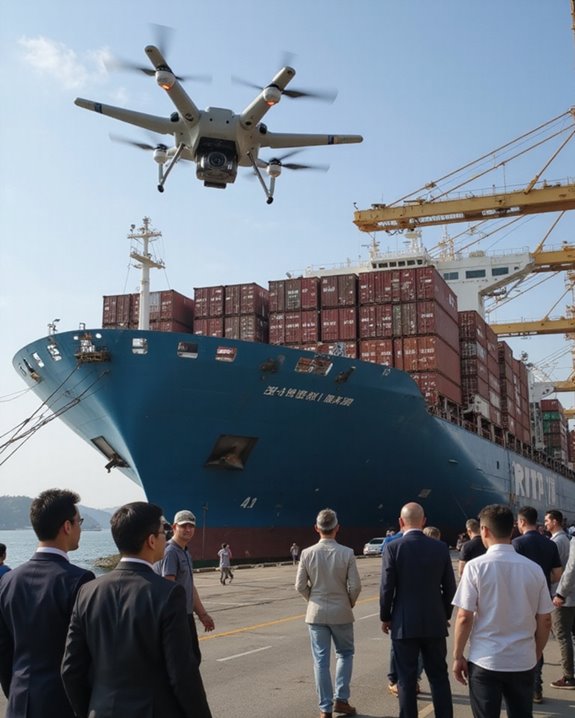
Imagine unboxing a drone and realizing it’s packed with way more than just spinning blades and a camera—today’s drones arriving from China are loaded with some seriously cool tech! These drones now come with Autonomous Features that let them make smart decisions on their own, like dodging trees or mapping crops, all without your help. Thermal Imaging is another game-changer; firefighters and search teams can spot heat sources or missing people, even in total darkness. You’ll also find laser rangefinders for exact measurements, AI-powered navigation for smarter flying, and swappable payloads—switch out a regular camera for a high-resolution thermal sensor in seconds. With extended battery life and advanced safety sensors, these drones are truly built for the future, not just for fun! Many professional-grade drones now feature GPS tracking and automated flight to ensure precise positioning and consistent data collection during missions.
Regional Market Trends and Competitive Landscape
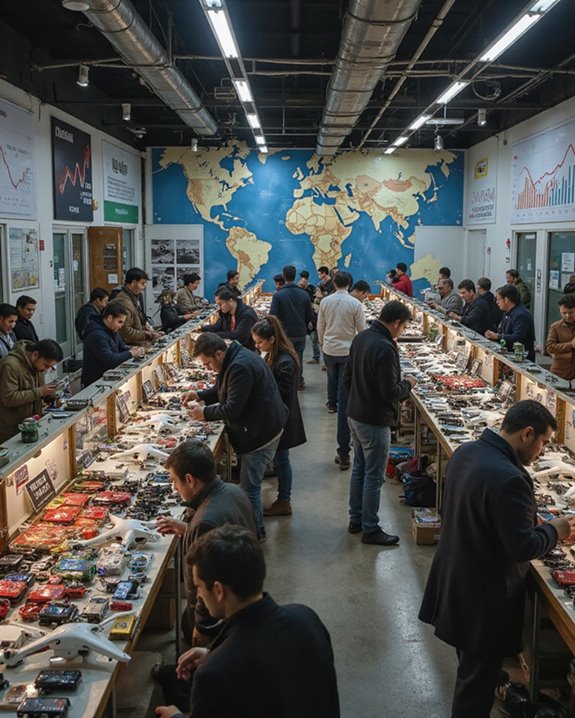
When it comes to drones imported from China, the global market is buzzing with action and serious competition! Did you know DJI, a giant from China, controls about 70% of the entire drone industry in 2024? That’s a lot of propellers spinning! Regional Alliances in Asia-Pacific—countries like Japan, India, and South Korea—are joining forces, fueling innovation and breaking down Competitive Barriers. Meanwhile, Germany leads Europe with smart investments and cool tech like AI-powered navigation. The U.S. is definitely in the race, but China’s commitment to research and friendly policies gives it a powerful edge. Markets are growing fast, especially in Asia-Pacific, with a projected CAGR over 15%. So, the drone world is a high-flying contest, packed with ambition and smart teamwork!
Frequently Asked Questions
What Are the Environmental Impacts of Drone Manufacturing and Shipping?
Drone manufacturing and shipping generate a significant carbon footprint through energy-intensive production, especially battery fabrication, and emissions from logistics. Material sourcing for metals and plastics drives environmental degradation, resource extraction, and e-waste, necessitating sustainable practices for mitigation.
How Are Drones Disposed of or Recycled After Use?
Drone disposal often involves landfill or incineration due to limited recycling infrastructure. Effective drone reuse and material upcycling face barriers from complex composites and batteries, though targeted recycling can recover aluminum and other materials, supporting energy savings and sustainability.
Are There Ethical Concerns With Importing Drones From Certain Countries?
Ethical concerns regarding drone imports center on human rights, ethical sourcing, and data privacy. Issues include potential surveillance, intellectual property risks, and compliance with international standards, prompting scrutiny over sourcing practices and supplier transparency in the global drone industry.
What Training Is Required to Operate Imported Drones Legally?
To operate imported drones legally, pilot training and legal certification are required. Operators must complete FAA-approved training, pass the Part 107 exam, obtain a Remote Pilot Certificate, and participate in recurrent training every 24 months to maintain compliance.
How Do Customs Regulations Affect Individual Consumers Importing Drones?
Like traversing a maze, individual consumers importing drones face customs regulations requiring accurate classification for customs duties and import tariffs. An incorrect turn—misclassification—can result in unexpected fines, delays, or even confiscation, underscoring the importance of compliance.



